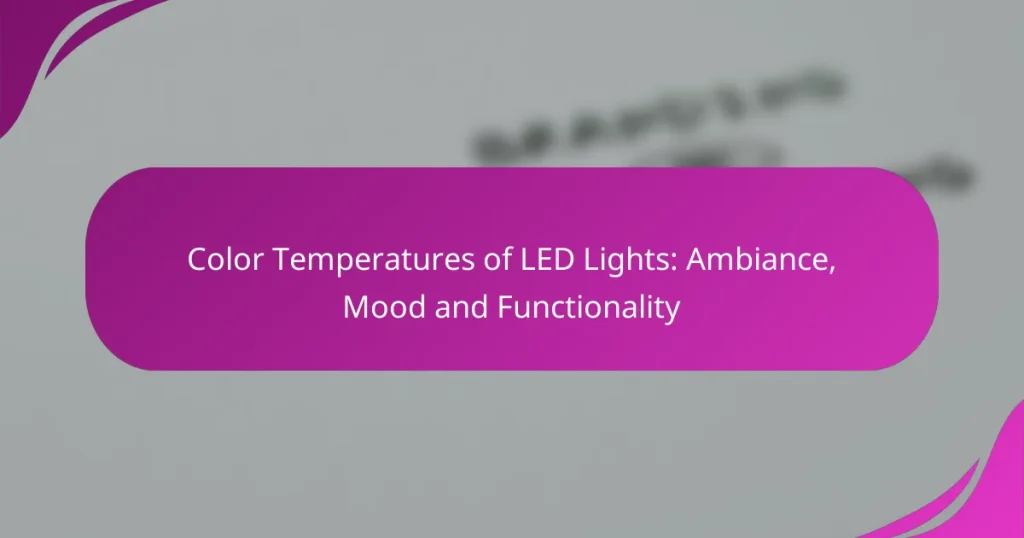Color temperatures of LED lights play a crucial role in shaping the ambiance and functionality of spaces within UK homes. Warmer tones, typically around 2700K, foster a cozy and inviting atmosphere, while cooler tones, such as 4000K, enhance focus and productivity. Understanding how to select the right color temperature for each room can significantly impact mood and overall experience.
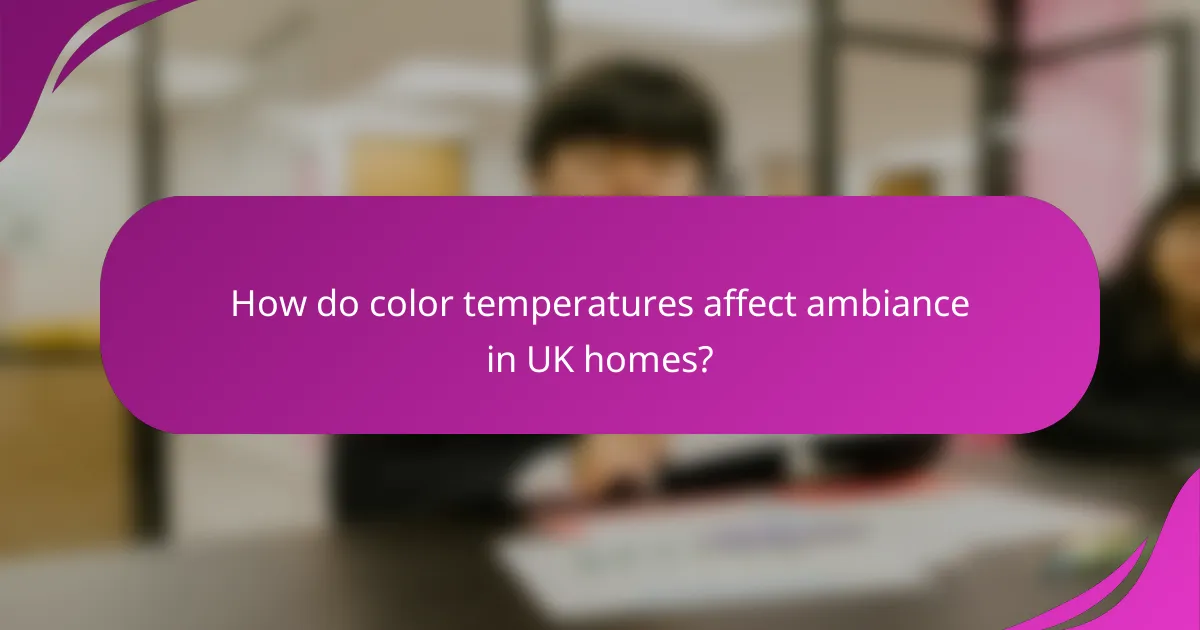
How do color temperatures affect ambiance in UK homes?
Color temperatures significantly influence the ambiance in UK homes by affecting how light interacts with interior spaces. Warmer tones create a cozy atmosphere, while cooler tones promote a modern, vibrant feel, making it essential to choose the right temperature for each room.
Warm white for cozy settings
Warm white light, typically ranging from 2700K to 3000K, is ideal for creating inviting and comfortable spaces. This color temperature mimics the glow of traditional incandescent bulbs, making it perfect for living rooms and bedrooms where relaxation is key.
To enhance a cozy setting, consider using warm white LED lights in lamps and fixtures. Dimmers can also help adjust brightness, allowing you to tailor the ambiance to different activities, such as reading or entertaining guests.
Cool white for modern aesthetics
Cool white light, generally between 3500K and 4100K, offers a sleek and contemporary look, making it suitable for kitchens and bathrooms. This color temperature provides a bright, clean appearance that enhances the functionality of these spaces.
Using cool white LEDs can help highlight modern design elements and improve visibility for tasks. However, be cautious not to overuse this temperature in living areas, as it may create a sterile or unwelcoming environment.
Daylight for vibrant environments
Daylight color temperatures, usually around 5000K to 6500K, simulate natural sunlight and are excellent for workspaces and areas requiring high concentration. This bright light can energize a room and improve focus, making it ideal for home offices or craft areas.
Incorporating daylight LEDs can enhance colors and details, making them suitable for art studios or reading nooks. However, be mindful of the potential for glare, and consider using softer lighting options in relaxation areas to maintain a balanced ambiance.
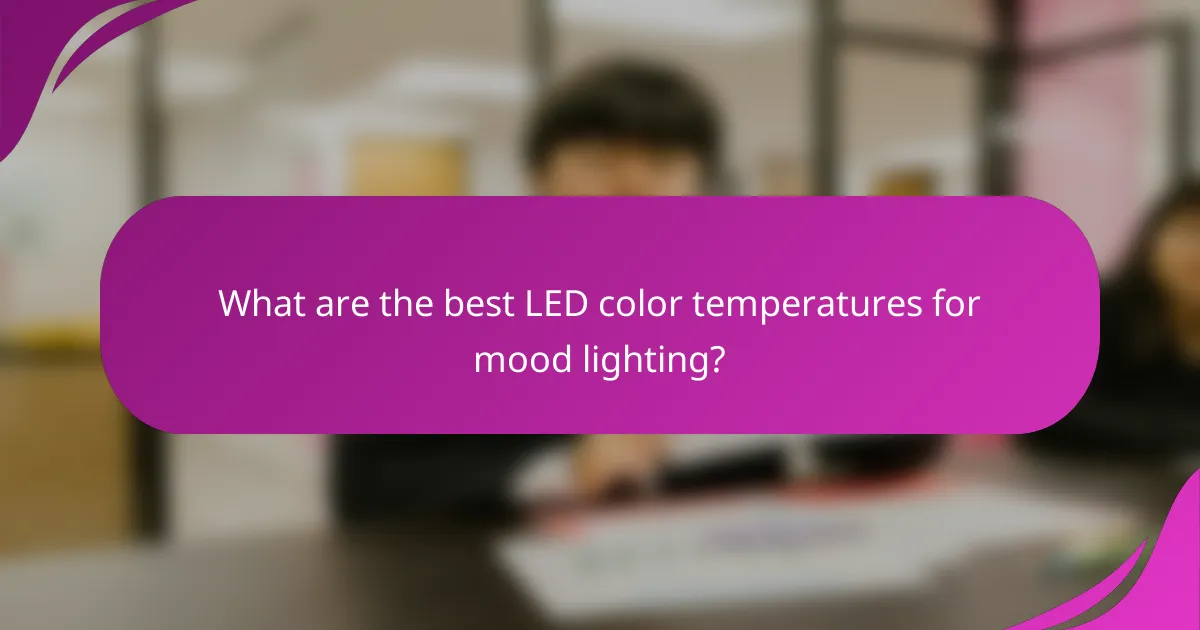
What are the best LED color temperatures for mood lighting?
The best LED color temperatures for mood lighting typically range from warm to cool tones, depending on the desired ambiance. Warm whites around 2700K create a cozy atmosphere, while cooler temperatures like 4000K can enhance focus and productivity.
2700K for relaxation
LED lights at 2700K provide a warm, soft glow that promotes relaxation and comfort. This color temperature is ideal for spaces like living rooms and bedrooms, where a calming environment is essential.
When using 2700K lighting, consider pairing it with dimmers to adjust brightness based on the time of day or activity. This flexibility allows you to create the perfect atmosphere for winding down in the evening.
3000K for inviting spaces
At 3000K, LED lights emit a warm white light that is both inviting and energizing. This temperature is suitable for dining areas and kitchens, where a welcoming ambiance encourages social interaction.
To enhance the inviting nature of 3000K lighting, use it in combination with warm-colored decor and furnishings. This will create a cohesive look that feels both comfortable and stylish.
4000K for productivity
LED lights at 4000K produce a neutral white light that enhances focus and alertness, making it ideal for workspaces and offices. This temperature helps reduce eye strain and supports productivity during tasks that require concentration.
To maximize the benefits of 4000K lighting, position it in areas where you perform detailed work, such as desks or craft stations. Additionally, consider using task lighting alongside ambient lighting to create a well-lit environment that fosters efficiency.
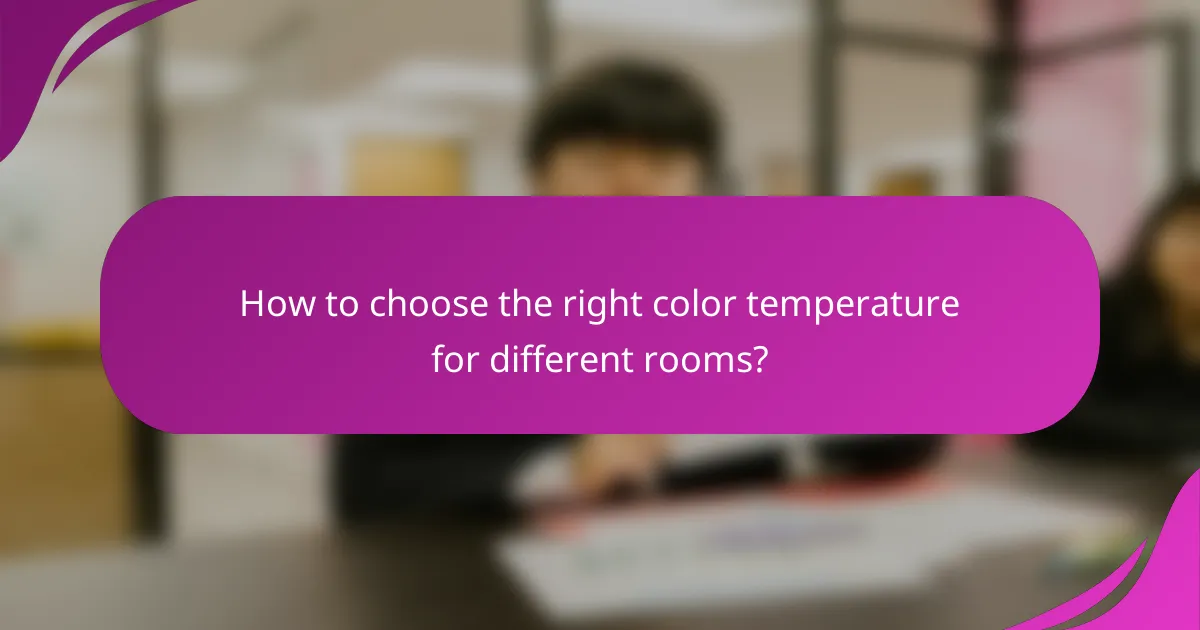
How to choose the right color temperature for different rooms?
Selecting the appropriate color temperature for various rooms enhances ambiance, mood, and functionality. Generally, warmer tones (around 2700K to 3000K) create a cozy atmosphere, while cooler tones (4000K and above) promote alertness and focus.
Living room recommendations
For living rooms, a color temperature between 2700K and 3000K is ideal. This range provides a warm, inviting glow that encourages relaxation and social interaction. Consider using dimmable LED lights to adjust the brightness according to the time of day or activity.
Incorporate layered lighting with floor lamps, table lamps, and wall sconces to create depth and interest. Using a mix of warm white and accent lighting can enhance the room’s overall aesthetic.
Bedroom suggestions
In bedrooms, aim for a color temperature of 2200K to 2700K to foster a calm and restful environment. Warmer light helps signal to your body that it’s time to wind down, promoting better sleep quality.
Consider using bedside lamps with adjustable brightness for reading or relaxing. Avoid harsh, cool lighting, especially in the evening, as it can disrupt your circadian rhythm.
Kitchen lighting tips
For kitchens, a color temperature of 3000K to 4000K is recommended. This range provides a bright, clean light that enhances visibility for cooking and food preparation. It helps create an energetic atmosphere while maintaining a welcoming feel.
Use task lighting under cabinets and over workspaces to ensure adequate illumination. Combining cooler tones with warmer accents can help balance functionality with comfort in this busy space.

What are the benefits of using LED lights in the UK?
LED lights offer numerous advantages in the UK, including energy efficiency, longevity, and low heat emission. These benefits make them a popular choice for both residential and commercial lighting solutions.
Energy efficiency
LED lights are significantly more energy-efficient than traditional incandescent bulbs, consuming up to 80% less electricity. This efficiency translates into lower energy bills, making them a cost-effective option for households and businesses alike.
When selecting LED lights, look for those with a high lumens-per-watt ratio. This indicates better brightness for less energy usage, helping you maximize savings while maintaining adequate lighting levels.
Longevity and durability
LED lights have a lifespan that can exceed 25,000 hours, far outlasting conventional bulbs, which typically last around 1,000 hours. This longevity means less frequent replacements, reducing waste and maintenance costs.
Additionally, LEDs are more durable than traditional bulbs, as they are less prone to breakage. This resilience makes them ideal for both indoor and outdoor applications, where exposure to elements can be a concern.
Low heat emission
One of the key benefits of LED lights is their low heat emission. Unlike incandescent bulbs that convert a significant portion of energy into heat, LEDs emit very little heat, making them safer to use and reducing cooling costs in warmer months.
This characteristic also allows for more versatile placement options, as LEDs can be installed in areas where heat-sensitive materials are present, minimizing the risk of fire hazards.

How does color temperature impact functionality in workspaces?
Color temperature significantly influences functionality in workspaces by affecting mood and productivity. Cooler tones, typically above 5000K, can enhance alertness, while warmer tones, around 2700K to 3000K, create a more relaxed environment.
Enhanced concentration with cool tones
Cool tones, ranging from 5000K to 6500K, mimic daylight and are known to boost concentration and focus. These temperatures are ideal for tasks requiring high attention to detail, such as reading or data analysis.
Incorporating cool LED lights in areas like offices or study rooms can lead to improved cognitive performance. Consider using adjustable lighting systems that allow you to switch between cool and warm tones based on the time of day or task at hand.
Reduced eye strain with warmer tones
Warmer tones, typically between 2700K and 3000K, are gentler on the eyes and can help reduce eye strain, especially in environments where people spend long hours working. This color temperature is suitable for spaces like lounges or meeting rooms where relaxation is key.
To create a comfortable workspace, consider using warmer LED lights in combination with natural light sources. This balance can help maintain a pleasant atmosphere while minimizing fatigue during extended periods of work.
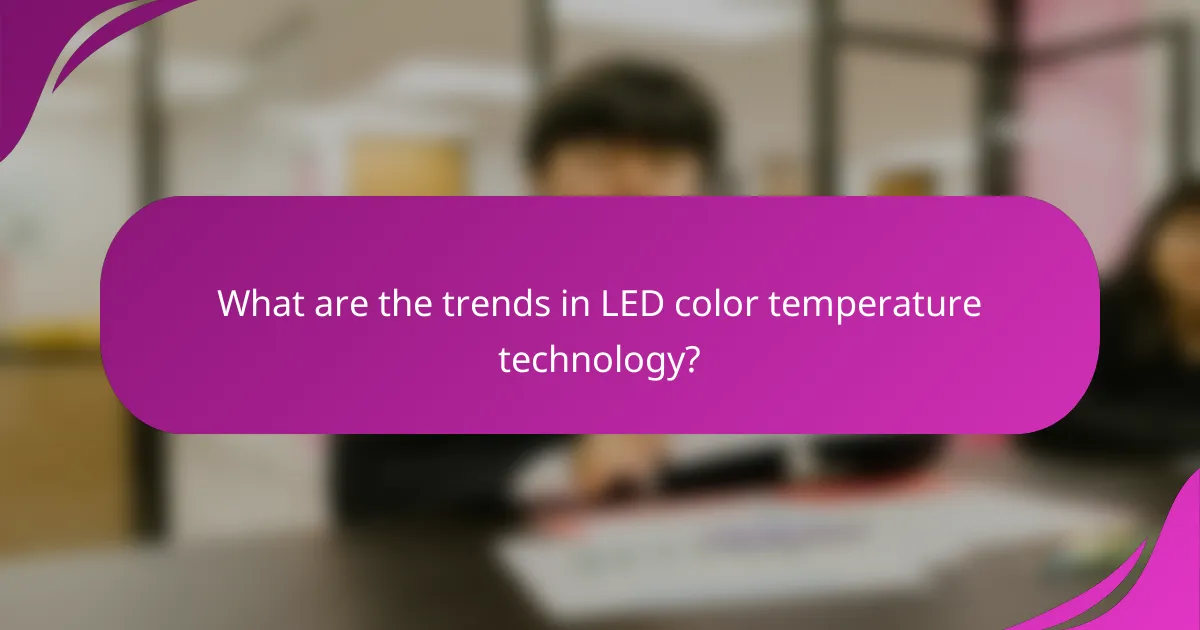
What are the trends in LED color temperature technology?
Recent trends in LED color temperature technology focus on enhancing user experience through adjustable lighting options and smart integration. Innovations allow users to select color temperatures that suit various activities and moods, ranging from warm whites for relaxation to cooler tones for productivity.
Smart lighting systems
Smart lighting systems are increasingly popular due to their ability to adjust color temperatures automatically based on time of day or user preferences. These systems often connect to smartphones or smart home hubs, allowing for remote control and customization.
When choosing a smart lighting system, consider compatibility with existing devices and the range of color temperatures offered. Many systems provide options from around 2700K (warm white) to 6500K (daylight), enabling users to create the desired ambiance for different settings.
To maximize the benefits of smart lighting, avoid systems that lack user-friendly interfaces or require complex setups. Look for features like voice control and scheduling to enhance convenience and functionality in your home or workspace.
